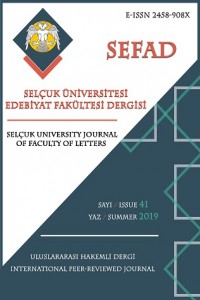Charlotte Brontë’nin Jane Eyre Adlı Romanının Postkolonyal-Oryantalist ve Feminist Okuması: “Ötekiler”
Öz
Bu makale ondokuzuncu yüzyıl
Viktorya Dönemi İngiliz Edebiyatı’nın önemli isimlerinden Charlotte Brontë’nin Jane Eyre isimli romanında “öteki” ve
“ötekileştirme” konusunu inceler. Bu amaç doğrultusunda, sınıf ve cinsiyet
konularını irdelemede kullanınılan Feminist teori romanın ana karakteri olan
Jane’in toplumdaki ötekileştirilmiş konumunun incelenmesinde kullanılırken;
romandaki Bertha karakterinin çözümlemesinde ise Postcolonyal-Orientalist
teoriden yararlanılmıştır. Bu iki kadın karakterin karşılaştırmalı bir “öteki”
okumasının yapıldığı bu makalenin ulaştığı sonuç ise yazarın dönemin İngiliz
toplumunda yerleşmiş bulunan cinsiyet ve sınıf ayrımcılığına karşıt—zayıf olsa
da—eleştirel bir tutum geliştirmesine rağmen, benzer bir serbestleştirici ve
teskin edici tutum ırksal öteki olarak konumlandırılan İngiliz kolonisinden
gelen Bertha için gösterilmemiştir. Bu da Edward Said’in iddia ettiği üzere,
İngiliz emperyalizminin doruk noktasını yaşadığı ondokuzuncu yüzyılda,
edebiyatın baskın politik inanışlar ve olgular çerçevesinde şekillenmiş
olabileceğine örnek teşkil etmesi bakımından önemlidir.
Anahtar Kelimeler
Jane Eyre sömürgecilik-oryantalizm öteki sınıf ve cinsiyet feminist eleştiri
Kaynakça
- Bell, M. (1996). Jane Eyre: The tale of the governess. The American Scholar, 65(2), 263-269.
- Brontë, C. (2001). Jane Eyre. New York: Norton Critical Edition.
- Brontë, C. (2010). Selected letters. M. Smith (Ed.). New York: Oxford University Press.
- Gilbert, S. M. & Gubar, S. (2000). The madwoman in the attic: The woman writer and the nineteenth-century literary imagination. New Haven: Yale University Press.
- Meyer, S. (1997). Colonialism and the figurative strategy of Jane Eyre. In H. Glen (Ed.), New case books Jane Eyre (pp. 92-130). New York: St. Martin’s Press.
- Peters, John G. (1996). Inside and outside: Jane Eyre and marginalization through labeling. Studies in the Novel, 28, 57-75.
- Politi, J. (1997). Jane Eyre class-ified. In H. Glen (Ed.), New case books Jane Eyre (pp. 78-91). New York: St. Martin’s Press.
- Said, E. (1994). Culture and imperialism. New York: Vintage Books.
- Spivak, G. C. (1985). Three women’s texts and a critique of imperialism. Critical Inquiry, 12, 243-261.
- Spivak, G. C. (1993). Can the subaltern speak?. In L. Chrisman & P. Williams (Eds.), Colonial discourse and post-colonial theory: a reader (pp. 66-111). New York: Harvester Wheatsheaf.
- Watson, R. (2001). Images of blackness in the works of Charlotte and Emily Brontë. CLA Journal, 44(4), 451-70.
Öz
There are different forms of
othering in Charlotte Brontë’s Jane Eyre: one which results from Jane’s ambiguous
position in terms of class hierarchies and another generated by Bertha’s
presence as a colonized subject. In both cases, femininity amplifies gender-specific
repercussions in these othering processes. However, while Brontë creates a
female character in Jane who triumphs over the challenges posed by Victorian
society’s class and gender hierarchies, i.e., the status as other of
governesses and women, problematic as it is in its final solidification of the
status quo, Bertha reflects the dominant, Eurocentric ideologies of nineteenth
century England concerning race and the racial other. She is the colonized and
racial other, a madwoman who threatens British men as embodied in Mr.
Rochester, and women embodied as in Jane, and her final self-destruction for
Jane’s sake are poignant plot devices to this end. This paper offers a comparative reading of
two female characters’ othered status in Victorian British society in relation
to the dominant ideologies of the era concerning gender, class and race. I
argue that whereas Brontë, following a feminist reading of her novel, fictively
assuages the othered status of British women in the characterization of Jane,
who triumphs in resisting society’s rigid class boundaries and women’s
subordinate position in terms of legal and financial matters, does not grant a
similarly fictive emancipatory view to Bertha as the colonized and racial
other. This is an obvious and clear indication of Brontë’s limitations
concerning feminist activism and inclusiveness as her implication in advancing
the dominant, imperialist discourse.
Anahtar Kelimeler
Jane Eyre post-colonialism-orientalism the other class and gender feminist criticism
Kaynakça
- Bell, M. (1996). Jane Eyre: The tale of the governess. The American Scholar, 65(2), 263-269.
- Brontë, C. (2001). Jane Eyre. New York: Norton Critical Edition.
- Brontë, C. (2010). Selected letters. M. Smith (Ed.). New York: Oxford University Press.
- Gilbert, S. M. & Gubar, S. (2000). The madwoman in the attic: The woman writer and the nineteenth-century literary imagination. New Haven: Yale University Press.
- Meyer, S. (1997). Colonialism and the figurative strategy of Jane Eyre. In H. Glen (Ed.), New case books Jane Eyre (pp. 92-130). New York: St. Martin’s Press.
- Peters, John G. (1996). Inside and outside: Jane Eyre and marginalization through labeling. Studies in the Novel, 28, 57-75.
- Politi, J. (1997). Jane Eyre class-ified. In H. Glen (Ed.), New case books Jane Eyre (pp. 78-91). New York: St. Martin’s Press.
- Said, E. (1994). Culture and imperialism. New York: Vintage Books.
- Spivak, G. C. (1985). Three women’s texts and a critique of imperialism. Critical Inquiry, 12, 243-261.
- Spivak, G. C. (1993). Can the subaltern speak?. In L. Chrisman & P. Williams (Eds.), Colonial discourse and post-colonial theory: a reader (pp. 66-111). New York: Harvester Wheatsheaf.
- Watson, R. (2001). Images of blackness in the works of Charlotte and Emily Brontë. CLA Journal, 44(4), 451-70.
Ayrıntılar
| Birincil Dil | İngilizce |
|---|---|
| Konular | Sanat ve Edebiyat |
| Bölüm | Makaleler |
| Yazarlar | |
| Yayımlanma Tarihi | 19 Haziran 2019 |
| Gönderilme Tarihi | 12 Eylül 2018 |
| Yayımlandığı Sayı | Yıl 2019 Sayı: 41 |
Cited By
The Image in the Mirror-A Feminist Study on the Autobiographical Elements in Jane Eyre
International Journal of Education and Humanities
https://doi.org/10.54097/ijeh.v6i1.3041
Selcuk University Journal of Faculty of Letters will start accepting articles for 2025 issues on Dergipark as of September 15, 2024.


